This is an old revision of this page, as edited by 65.95.128.109 (talk) at 23:11, 17 January 2009 (Proper grammer+spelling). The present address (URL) is a permanent link to this revision, which may differ significantly from the current revision.
Revision as of 23:11, 17 January 2009 by 65.95.128.109 (talk) (Proper grammer+spelling)(diff) ← Previous revision | Latest revision (diff) | Newer revision → (diff)For other uses, see Austria (disambiguation).
| Commonwealth of Australia | |
|---|---|
 Flag
Flag
 Coat of arms
Coat of arms
| |
| Anthem: Advance Australia Fair | |
 | |
| Capital | Canberra |
| Largest city | Sydney |
| Official languages | None |
| National language | English (de facto) |
| Ethnic groups | 29.01% Australian, 0.45% Australian Aboriginal, 51.29% European (English, Irish, Scottish, German, Italian, others), 4.87% Asian, 8.04% Other, 6.33% Unstated |
| Demonym(s) | Australian, Aussie (colloquial) |
| Government | Federal parliamentary democracy and constitutional monarchy, see Government of Australia |
| • Monarch | Queen Elizabeth II |
| • Governor-General | Quentin Bryce |
| • Prime Minister | Kevin Rudd |
| Independence from the United Kingdom | |
| • Constitution | 1 January 1901 |
| • Statute of Westminster | 11 December 1931 |
| • Statute of Westminster Adoption Act | 9 October 1942 (with effect from 3 September 1939) |
| • Australia Act | 3 March 1986 |
| Area | |
| • Total | 7,741,220 km (2,988,900 sq mi) (6th) |
| • Water (%) | 1 |
| Population | |
| • 2008 estimate | 21,468,700 (53rd) |
| • 2006 census | 19,855,288 |
| • Density | 2.6/km (6.7/sq mi) (235th) |
| GDP (PPP) | 2007 estimate |
| • Total | $762.887 billion (17th) |
| • Per capita | $36,225 (14th) |
| GDP (nominal) | 2008 estimate |
| • Total | $1,069 billion (DFAT) (15th) |
| • Per capita | $50,150 (DFAT) (16th) |
| HDI (2006) | Error: Invalid HDI value (4th) |
| Currency | Australian dollar (AUD) |
| Time zone | UTC+8 to +10.5 (various) |
| • Summer (DST) | UTC+9 to +11.5 (various) |
| Drives on | Left |
| Calling code | 61 |
| ISO 3166 code | AU |
| Internet TLD | .au |
Australia, officially the Commonwealth of Australia, is a country in the southern hemisphere comprising the mainland of the world's smallest continent, the major island of Tasmania, and numerous other islands in the Indian and Pacific Oceans. Neighbouring countries include Indonesia, East Timor, and Papua New Guinea to the north, the Solomon Islands, Vanuatu, and New Caledonia to the north-east, and New Zealand to the south-east.
For around 40,000 years before European settlement commenced in the late 18th century, the Australian mainland and Tasmania were inhabited by around 250 individual nations of indigenous Australians. After sporadic visits by fishermen from the immediate north, and European discovery by Dutch explorers in 1606, the eastern half of Australia was claimed by the British in 1770 and initially settled through penal transportation to the colony of New South Wales, founded on 26 January 1788. The population grew steadily in the following years; the continent was explored, and during the 19th century another five largely self-governing Crown Colonies were established.
On 1 January 1901, the six colonies became a federation, and the Commonwealth of Australia was formed. Since Federation, Australia has maintained a stable liberal democratic political system and remains a Commonwealth realm. The population is just over 21.3 million, with approximately 60% concentrated in and around the mainland state capitals of Sydney, Melbourne, Brisbane, Perth, and Adelaide. The nation's capital city is Canberra, located in the Australian Capital Territory (ACT).
Technologically advanced and industrialized, Australia is a prosperous multicultural country and has good results in many international comparisons of national performance such as health care, life expectancy, quality-of-life, human development, public education, economic freedom, and the protection of civil liberties and political rights.
Etymology

The name Australia is derived from the Latin Australis, meaning "Southern". Legends of an "unknown land of the south" (terra australis incognita) date back to Roman times and were commonplace in medieval geography but were not based on any documented knowledge of the continent. In 1521 Spaniards were among the first Europeans to sail the Pacific Ocean. The first use of the word Australia in English was in 1625, in "A note of Australia del Espiritu Santo, written by Master Hakluyt", published by Samuel Purchas in Hakluytus Posthumus. The Dutch adjectival form Australische was used by Dutch East India Company officials in Batavia to refer to the newly discovered land to the south in 1638. Australia was used in a 1693 translation of Les Aventures de Jacques Sadeur dans la Découverte et le Voyage de la Terre Australe, a 1676 French novel by Gabriel de Foigny under the pen-name Jacques Sadeur. Alexander Dalrymple then used it in An Historical Collection of Voyages and Discoveries in the South Pacific Ocean (1771), to refer to the entire South Pacific region. In 1793, George Shaw and Sir James Smith published Zoology and Botany of New Holland, in which they wrote of "the vast island, or rather continent, of Australia, Australasia or New Holland".
The name Australia was popularised by the 1814 work A Voyage to Terra Australis by the navigator Matthew Flinders, the first person known to have circumnavigated Australia. Though its title reflected the British Admiralty's usage, Flinders used the word Australia in his book, and because it was widely read it gave the term general currency. Governor Lachlan Macquarie of New South Wales subsequently used the word in his dispatches to England, and on 12 December 1817 recommended to the Colonial Office that it be formally adopted. In 1824, the Admiralty agreed that the continent should be known officially as Australia.
The word Australia in Australian English is Template:Pron-en-au. Since early in the 20th century the country is sometimes referred to locally and internationally as Oz. Aussie (less frequently spelt Ozzie, better representing the pronunciation) is common colloquially as an adjective, and as a noun referring to an Australian.
History
Main article: History of AustraliaHuman habitation of Australia is estimated to have begun between 42,000 and 48,000 years ago. These first Australians may have been ancestors of modern Indigenous Australians; they may have arrived via land bridges and short sea-crossings from what is now South-East Asia. Most of these people were hunter-gatherers, with a complex oral culture and spiritual values based on reverence for the land and a belief in the Dreamtime. The Torres Strait Islanders, ethnically Melanesian, were originally horticulturalists and hunter-gatherers. Their cultural practices have always been distinct from those of the Aborigines.

The first recorded European sighting of the Australian mainland was made by the Dutch navigator Willem Janszoon, who sighted the coast of Cape York Peninsula in 1606. During the 17th century, the Dutch charted the whole of the western and northern coastlines of what they called New Holland, but they made no attempt at settlement. In 1770, James Cook sailed along and mapped the east coast of Australia, which he named New South Wales and claimed for Great Britain.
Cook's discoveries prepared the way for establishment of a new penal colony. The British Crown Colony of New South Wales began a settlement at Port Jackson by Captain Arthur Phillip on 26 January 1788. This date was later to become Australia's national day, Australia Day. Van Diemen's Land, now known as Tasmania, was settled in 1803 and became a separate colony in 1825. The United Kingdom formally claimed the western part of Australia in 1829. Separate colonies were created from parts of New South Wales: South Australia in 1836, Victoria in 1851, and Queensland in 1859. The Northern Territory was founded in 1911 when it was excised from South Australia. South Australia was founded as a "free province"—that is, it was never a penal colony. Victoria and Western Australia were also founded "free" but later accepted transported convicts. The transportation of convicts to the colony of New South Wales ceased in 1848 after a campaign by the settlers.

The Indigenous Australian population, estimated at 350,000 at the time of European settlement, declined steeply for 150 years following settlement, mainly because of infectious disease combined with forced re-settlement and cultural disintegration. The removal of children from their families, which historians such as Henry Reynolds and Indigenous Australians have argued could be considered genocide by some definitions, may have contributed to the decline in the indigenous population. Such interpretations of Aboriginal history are disputed by some commentators as being exaggerated or fabricated for political or ideological reasons. This debate is known within Australia as the History Wars. Following the 1967 referendum, the Federal government gained the power to implement policies and make laws with respect to Aborigines. Traditional ownership of land—native title—was not recognised until 1992, when the High Court case Mabo v Queensland (No 2) overturned the notion of Australia as terra nullius (literally "no one's land", effectively "empty land") at the time of European occupation.
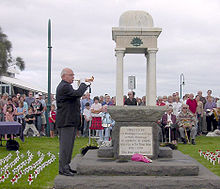
A gold rush began in Australia in the early 1850s, and the Eureka Stockade rebellion against mining licence fees in 1854 was an early expression of civil disobedience. Between 1855 and 1890, the six colonies individually gained responsible government, managing most of their own affairs while remaining part of the British Empire. The Colonial Office in London retained control of some matters, notably foreign affairs, defence, and international shipping. On 1 January 1901, federation of the colonies was achieved after a decade of planning, consultation, and voting. The Commonwealth of Australia was born as a dominion of the British Empire. The Federal Capital Territory (later renamed the Australian Capital Territory) was formed from a part of New South Wales in 1911 to provide a location for the proposed new federal capital of Canberra. (Melbourne was the temporary seat of government from 1901 to 1927 while Canberra was being constructed.) The Northern Territory was transferred from the control of the South Australian government to the Commonwealth in 1911. Australia willingly participated in World War I. Many Australians regard the defeat of the Australian and New Zealand Army Corps (ANZACs) at Gallipoli as the birth of the nation—its first major military action. The Kokoda Track Campaign is regarded by many as an analogous nation-defining event during World War II.
The United Kingdom's Statute of Westminster 1931 formally ended most of the constitutional links between Australia and the UK. Australia adopted it in 1942, but backdated it to the beginning of World War II to confirm the validity of legislation passed by the Australian Parliament during the war. The shock of the UK's defeat in Asia in 1942 and the threat of Japanese invasion caused Australia to turn to the United States as a new ally and protector. Since 1951, Australia has been a formal military ally of the US, under the ANZUS treaty. After World War II, Australia encouraged immigration from Europe; since the 1970s and the abolition of the White Australia policy, immigration from Asia and elsewhere was also encouraged. As a result, Australia's demography, culture, and self-image have been transformed. The final constitutional ties between Australia and the UK were severed with the passing of the Australia Act 1986, ending any British role in the government of the Australian States, and ending judicial appeals to the UK Privy Council. At the 1999 referendum, 54% of Australian voters rejected a proposal to become a republic with a president appointed by two-thirds vote of both houses of the Australian Parliament. Since the election of the Whitlam Government in 1972, there has been an increasing focus on the expansion of ties with other Pacific Rim nations while maintaining close ties with Australia's traditional allies and trading partners.
Politics
Main articles: Government of Australia, Politics of Australia, and Monarchy in Australia
The Commonwealth of Australia is a constitutional democracy based on a federal division of powers. The form of government used in Australia is a constitutional monarchy with a parliamentary system of government. Queen Elizabeth II is the Queen of Australia, a role that is distinct from her position as monarch of the other Commonwealth realms. The Queen is represented by the Governor-General at federal level and by the Governors at state level. Although the Constitution gives extensive executive powers to the Governor-General, these are normally exercised only on the advice of the Prime Minister. The most notable exercise of the Governor-General's reserve powers outside the Prime Minister's direction was the dismissal of the Whitlam Government in the constitutional crisis of 1975.
There are three branches of government:
- The legislature: the Commonwealth Parliament, comprising the Queen, the Senate, and the House of Representatives; the Queen is represented by the Governor-General, who by convention acts on the advice of his or her Ministers.
- The executive: the Federal Executive Council (the Governor-General as advised by the Executive Councillors); in practice, the councillors are the Prime Minister and Ministers of State.
- The judiciary: the High Court of Australia and other federal courts. Appeals from Australian courts to the Judicial Committee of the Privy Council in the United Kingdom ceased when the Australia Act was passed in 1986.
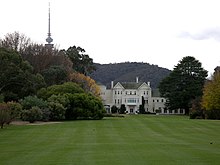
The bicameral Commonwealth Parliament consists of the Queen, the Senate (the upper house) of 76 senators, and a House of Representatives (the lower house) of 150 members. Members of the lower house are elected from single-member constituencies, commonly known as "electorates" or "seats", allocated to states on the basis of population, with each original state guaranteed a minimum of five seats. In the Senate, each state is represented by twelve senators, and each of the territories (the Australian Capital Territory and the Northern Territory) by two. Elections for both chambers are normally held every three years, simultaneously; senators have overlapping six-year terms, since only half of places in the Senate are put to each election unless the cycle is interrupted by a double dissolution. The party with majority support in the House of Representatives forms government and its leader becomes Prime Minister.
There are two major political groups that form government, federally and in the states: the Australian Labor Party, and the Coalition which is a formal grouping of two parties: the Liberal Party and its minor partner, the National Party. Independent members and several minor parties—including the Greens and the Australian Democrats—have achieved representation in Australian parliaments, mostly in upper houses. Since the election of 3 December 2007, the Labor Party led by the Prime Minister Kevin Rudd has been in power. Australian parliament (federal, state, and territory) then had a Labor government, until September 2008 when the Liberal Party formed a minority government in association with the National Party in Western Australia. In the 2004 election, the previous governing coalition led by John Howard won control of the Senate—the first time in more than 20 years that a party (or a coalition) has done so while in government. Voting is compulsory for all enrolled citizens 18 years and over, in each state and territory and at the federal level. Enrolment to vote is compulsory in all jurisdictions except South Australia.
States and territories
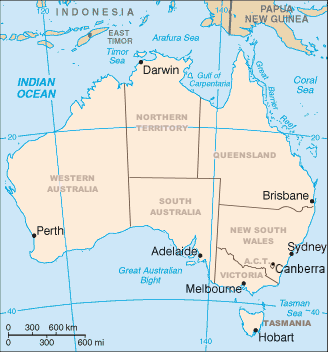
Australia has six states and two major mainland territories. There are also lesser territories that are under the administration of the federal government.
The states are New South Wales, Queensland, South Australia, Tasmania, Victoria, and Western Australia. The two major mainland territories are the Northern Territory and the Australian Capital Territory (ACT). In most respects these two territories function like states, but the Commonwealth Parliament can override any legislation of their parliaments. By contrast, federal legislation only overrides state legislation in certain areas that are set out in Section 51 of the Australian Constitution; state parliaments retain all residual legislative powers, including powers over hospitals, education, police, the judiciary, roads, public transport, and local government.
Each state and major mainland territory has its own legislature or parliament: unicameral in the Northern Territory, the ACT, and Queensland, and bicameral in the remaining states. The states are sovereign, though subject to certain powers of the Commonwealth as defined by the Constitution. The lower house is known as the Legislative Assembly (House of Assembly in South Australia and Tasmania) and the upper house is known as the Legislative Council. The head of the government in each state is the Premier, and in each territory the Chief Minister. The Queen is represented in each state by a Governor; an Administrator in the Northern Territory, and the Australian Governor-General in the ACT, have analogous roles.
The federal government directly administers the following territories: Jervis Bay Territory (a naval base and sea port for the national capital—land that was formerly part of New South Wales); Norfolk Island, Christmas Island, and Cocos (Keeling) Islands (inhabited external territories); and Ashmore and Cartier Islands, Coral Sea Islands, Heard Island and McDonald Islands, and the Australian Antarctic Territory (largely uninhabited).
Foreign relations and military
Main articles: Foreign relations of Australia and Australian Defence Force

Over recent decades, Australia's foreign relations have been driven by a close association with the United States through the ANZUS pact, and by a desire to develop relationships with Asia and the Pacific, particularly through ASEAN and the Pacific Islands Forum. In 2005 Australia secured an inaugural seat at the East Asia Summit following its accession to the Treaty of Amity and Cooperation. Australia is a member of the Commonwealth of Nations, in which the Commonwealth Heads of Government meetings provide the main forum for cooperation. Australia has energetically pursued the cause of international trade liberalisation. It led the formation of the Cairns Group and Asia-Pacific Economic Cooperation. Australia is a member of the Organisation for Economic Co-operation and Development and the World Trade Organization, and has pursued several major bilateral free trade agreements, most recently the Australia-United States Free Trade Agreement and Closer Economic Relations with New Zealand. A founding member country of the United Nations, Australia also maintains an international aid program under which some 60 countries receive assistance. The 2005–06 budget provides A$2.5 billion for development assistance; as a percentage of GDP, this contribution is less than that recommended in the UN Millennium Development Goals. Australia ranks 7th overall in the Center for Global Development's 2008 Commitment to Development Index.
Australia's armed forces—the Australian Defence Force (ADF)—comprise the Royal Australian Navy (RAN), the Australian Army, and the Royal Australian Air Force (RAAF), numbering about 51,000. All branches of the ADF have been involved in UN and regional peacekeeping (most recently in East Timor, the Solomon Islands, and Sudan), disaster relief, and armed conflict, including the 2003 invasion of Iraq. The government appoints the Chief of the Defence Force from one of the armed services; the current Chief of the Defence Force is Air Chief Marshal Angus Houston. In the 2006–07 budget, defence spending was A$22 billion, accounting for less than 1% of global military spending. While the Governor-General is the Commander-in-Chief of the Australian Defence Force, he or she does not play an active part in the ADF's command structure; the elected Australian Government controls the ADF.
Geography
Main articles: Geography of Australia, Climate of Australia, and Environment in Australia
Australia's landmass of 7,617,930 square kilometres (2,941,300 sq mi) is on the Indo-Australian Plate. Surrounded by the Indian and Pacific oceans, Australia is separated from Asia by the Arafura and Timor seas. Australia has 34,218 kilometres (21,262 mi) of coastline (excluding all offshore islands) and claims an extensive exclusive economic zone of 8,148,250 square kilometres (3,146,060 sq mi). This exclusive economic zone does not include the Australian Antarctic Territory.
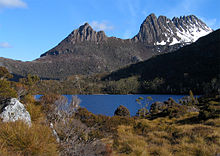
The Great Barrier Reef, the world's largest coral reef, lies a short distance off the north-east coast and extends for over 2,000 kilometres (1,240 mi). Mount Augustus, claimed to be the world's largest monolith, is located in Western Australia. At 2,228 metres (7,310 ft), Mount Kosciuszko on the Great Dividing Range is the highest mountain on the Australian mainland, although Mawson Peak on the remote Australian territory of Heard Island is taller at 2,745 metres (9,006 ft).
By far the largest part of Australia is desert or semi-arid lands commonly known as the outback. Australia is the flattest continent, with the oldest and least fertile soils, and is the driest inhabited continent. Only the south-east and south-west corners of the continent have a temperate climate. A great proportion of the population lives along the temperate south-eastern coastline. The landscapes of the northern part of the country, with a tropical climate, consist of rainforest, woodland, grassland, mangrove swamps, and desert. The climate is significantly influenced by ocean currents, including the El Niño southern oscillation, which is correlated with periodic drought, and the seasonal tropical low pressure system that produces cyclones in northern Australia.
Climate change has become an increasing concern in Australia in recent years, with many Australians considering it to be the most important issue facing the country. The first Rudd Ministry has initiated several emission reduction activities; Rudd's first official act, on his first day in office, was to sign the instrument of ratification of the Kyoto Protocol. Nevertheless Australia's carbon dioxide emissions per capita are among the highest in the world, lower than only several other industrialized nations including the United States, Canada, and Norway. Rainfall in Australia has increased over the past century, both nationwide and for all four quadrants of the nation. Despite this beneficial effect of climate change, water restrictions are currently in place in many regions and cities of Australia in response to chronic shortages due to urban population increases and localised drought.
Ecology
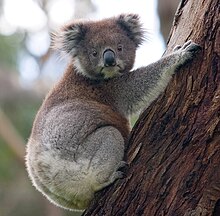
Although most of Australia is semi-arid or desert, it includes a diverse range of habitats from alpine heaths to tropical rainforests, and is recognised as a megadiverse country. Because of the continent's great age, its extremely variable weather patterns, and its long-term geographic isolation, much of Australia's biota is unique and diverse. About 85% of flowering plants, 84% of mammals, more than 45% of birds, and 89% of in-shore, temperate-zone fish are endemic. Australia has the greatest number of reptiles of any country, with 755 species. Many of Australia's ecoregions, and the species within those regions, are threatened by human activities and introduced plant and animal species. The federal Environment Protection and Biodiversity Conservation Act 1999 is a legal framework for the protection of threatened species. Numerous protected areas have been created under the national Biodiversity Action Plan to protect and preserve unique ecosystems; 64 wetlands are registered under the Ramsar Convention, and 16 World Heritage Sites have been established. Australia was ranked 13th in the world on the 2005 Environmental Sustainability Index. Australian forests often contain a wide variety of eucalyptus trees and are mostly located in higher rainfall regions.
Most Australian woody plant species are evergreen and many are adapted to fire and drought, including many eucalypts and acacias. Australia has a rich variety of endemic legume species that thrive in nutrient-poor soils because of their symbiosis with rhizobia bacteria and mycorrhizal fungi. Among well-known Australian fauna are the monotremes (the platypus and the echidna); a host of marsupials, including the kangaroo, the koala, and the wombat; the saltwater and freshwater crocodiles; and birds such as the emu and the kookaburra. Australia is home to some of the most venomous snakes in the world. The dingo was introduced by Austronesian people who traded with Indigenous Australians around 3000 BCE. Many plant and animal species became extinct soon after first human settlement, including the Australian megafauna; others have become extinct since European settlement, among them the thylacine.
Economy
Main article: Economy of Australia See also: Economic history of Australia and Median household income in Australia and New Zealand
The Australian dollar is the currency of the Commonwealth of Australia, including Christmas Island, Cocos (Keeling) Islands, and Norfolk Island, as well as the independent Pacific Island states of Kiribati, Nauru, and Tuvalu. The Australian Securities Exchange and the Sydney Futures Exchange are the largest stock exchanges in Australia.
Australia is one of the most laissez-faire capitalist economies, according to indices of economic freedom. Australia's per capita GDP is slightly higher than that of the UK, Germany, and France in terms of purchasing power parity. The country was ranked third in the United Nations 2007 Human Development Index, first in the 2008 Prosperity Index, and sixth in The Economist worldwide Quality-of-Life Index for 2005. Australia also broke a record in 2008 when four of its major cities reached the top ten of The Economist's World's Most Livable Cities list, with Melbourne ranked at 2nd, Perth at 4th, Adelaide at 7th, and Sydney at 9th. The emphasis on exporting commodities rather than manufactures has underpinned a significant increase in Australia's terms of trade during the rise in commodity prices since the start of the century. Australia has a balance of payments that is more than 7% of GDP negative, and has had persistently large current account deficits for more than 50 years. Australia has grown at an average annual rate of 3.6% for over 15 years, a period in which the OECD annual average was 2.5%.
The Hawke Government floated the Australian dollar in 1983 and partially deregulated the financial system. The Howard government followed with a partial deregulation of the labour market and the further privatisation of state-owned businesses, most notably in the telecommunications industry. The indirect tax system was substantially changed in July 2000 with the introduction of a 10% Goods and Services Tax (GST), which has slightly reduced the reliance on personal and company income tax that characterises Australia's tax system.
In January 2007, there were 10,033,480 people employed, with an unemployment rate of 4.6%. Over the past decade, inflation has typically been 2–3% and the base interest rate 5–6%. The service sector of the economy, including tourism, education, and financial services, accounts for 69% of GDP. Although agriculture and natural resources account for only 3% and 5% of GDP respectively, they contribute substantially to export performance. Australia's largest export markets are Japan, China, the US, South Korea, and New Zealand.
Demography
Main articles: Demographics of Australia and Immigration to Australia| Historical populations | ||
|---|---|---|
| Year | Population | Increase |
| 1788 | 900 | — |
| 1800 | 5,200 | 477.8% |
| 1850 | 405,400 | 7,696.2% |
| 1900 | 3,765,300 | 828.8% |
| 1910 | 4,525,100 | 20.2% |
| 1920 | 5,411,000 | 19.6% |
| 1930 | 6,501,000 | 20.1% |
| 1940 | 7,078,000 | 8.9% |
| 1950 | 8,307,000 | 17.4% |
| 1960 | 10,392,000 | 25.1% |
| 1970 | 12,663,000 | 21.9% |
| 1980 | 14,726,000 | 16.3% |
| 1990 | 17,169,000 | 16.6% |
| 2000 | 19,169,100 | 11.6% |
| 2008 Estimate | 21,370,800 | 11.5% |
Most of the estimated 21.3 million Australians are descended from colonial-era settlers and post-Federation immigrants from Europe, with almost 90% of the population being of European descent. For generations, the vast majority of both colonial-era settlers and post-Federation immigrants came almost exclusively from the British Isles, and the people of Australia are still mainly of British or Irish ethnic origin.
Australia's population has quadrupled since the end of World War I, spurred by an ambitious immigration program. Following World War II and through to 2000, almost 5.9 million of the total population settled in the country as new immigrants, meaning that nearly two out of every seven Australians were born overseas. Most immigrants are skilled, but the immigration quota includes categories for family members and refugees. In 2001, the five largest groups of the 23.1% of Australians who were born overseas were from the United Kingdom, New Zealand, Italy, Vietnam, and China. Following the abolition of the White Australia policy in 1973, numerous government initiatives have been established to encourage and promote racial harmony based on a policy of multiculturalism. In 2005–06, more than 131,000 people emigrated to Australia, mainly from Asia and Oceania. The migration target for 2006–07 was 144,000.

Australia opens its doors to about 300,000 new migrants in 2008–09—its highest level since the Immigration Department was created after World War II.
The Indigenous population—mainland Aborigines and Torres Strait Islanders—was 410,003 (2.2% of the total population) in 2001, a significant increase from the 1976 census, which showed an indigenous population of 115,953. Indigenous Australians suffer from higher rates of imprisonment and unemployment, lower levels of education, and life expectancies for males and females that are 17 years lower than those of non-indigenous Australians. Remote Indigenous communities in Australia have been described as having "failed state"-like conditions.
In common with many other developed countries, Australia is experiencing a demographic shift towards an older population, with more retirees and fewer people of working age. In 2004, the average age of the civilian population was 38.8 years. A large number of Australians (759,849 for the period 2002–03) live outside their home country.
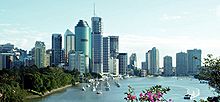
English is the national language. Australian English is a major variety of the language, with its own distinctive accent and vocabulary (some of which has found its way into standard English), but less internal dialectal variation (apart from small regional pronunciation and lexical variations) than either British or American English. Grammar and spelling are largely based on those of British English. According to the 2001 census, English is the only language spoken in the home for around 80% of the population. The next most common languages spoken at home are Chinese (2.1%), Italian (1.9%), and Greek (1.4%). A considerable proportion of first- and second-generation migrants are bilingual. It is believed that there were between 200 and 300 Australian Aboriginal languages at the time of first European contact. Only about 70 of these languages have survived, and all but 20 of these are now endangered. An indigenous language remains the main language for about 50,000 (0.25%) people. Australia has a sign language known as Auslan, which is the main language of about 6,500 deaf people.
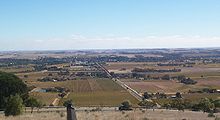
Australia has no state religion. In the 2006 census, 64% of Australians were listed as Christian of any denomination, including 26% as Roman Catholic and 19% as Anglican. "No religion" (which includes humanism, atheism, agnosticism, and rationalism) accounted for 19%; and a further 12% declined to answer or did not give a response adequate for interpretation. The fastest-growing and second largest religion in Australia is Buddhism, followed by Hinduism and Islam. Overall about 5% of Australians identify with non-Christian religions. Surveys have found Australia to be one of the least devout nations in the developed world, with religion not described as an important part in many Australians' lives. As in many Western countries, the level of active participation in church worship is low and in decline; weekly attendance at church services in 2004 was about 1.5 million: about 7.5% of the population.
School attendance is compulsory throughout Australia, starting at 6 years and ending at 15 years (16 years in South Australia and Tasmania and 17 years in Western Australia and Queensland), contributing to an adult literacy rate that is assumed to be 99%. The Programme for International Student Assessment, coordinated by the Organisation for Economic Co-operation and Development (OECD), currently ranks Australia's education as the eighth best in the world, significantly higher than the average world ranking among the the thirty OECD countries. Government grants have supported the establishment of Australia's 38 universities; and although several private universities have been established, the majority receive government funding. There is a state-based system of vocational training, higher than colleges, known as TAFE Institutes, and many trades conduct apprenticeships for training new tradespeople. Approximately 58% of Australians aged from 25 to 64 have vocational or tertiary qualifications, and the tertiary graduation rate of 49% is the highest among OECD countries. The ratio of international to local students in tertiary education in Australia is the highest in the OECD countries.
| Largest populated areas in Australia 2021 data from Australian Bureau of Statistics | |||||||||
|---|---|---|---|---|---|---|---|---|---|
| Rank | Name | State | Pop. | Rank | Name | State | Pop. | ||
| 1 | Sydney | NSW | 5,259,764 | 11 | Geelong | Vic | 289,400 | ||
| 2 | Melbourne | Vic | 4,976,157 | 12 | Hobart | Tas | 251,047 | ||
| 3 | Brisbane | Qld | 2,568,927 | 13 | Townsville | Qld | 181,665 | ||
| 4 | Perth | WA | 2,192,229 | 14 | Cairns | Qld | 155,638 | ||
| 5 | Adelaide | SA | 1,402,393 | 15 | Darwin | NT | 148,801 | ||
| 6 | Gold Coast–Tweed Heads | Qld/NSW | 706,673 | 16 | Toowoomba | Qld | 143,994 | ||
| 7 | Newcastle–Maitland | NSW | 509,894 | 17 | Ballarat | Vic | 111,702 | ||
| 8 | Canberra–Queanbeyan | ACT/NSW | 482,250 | 18 | Bendigo | Vic | 102,899 | ||
| 9 | Sunshine Coast | Qld | 355,631 | 19 | Albury-Wodonga | NSW/Vic | 97,676 | ||
| 10 | Wollongong | NSW | 305,880 | 20 | Launceston | Tas | 93,332 | ||
Culture
Main articles: Culture of Australia, Cinema of Australia, and Music of Australia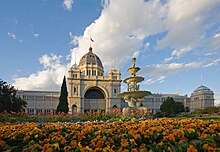
Since 1788, the primary basis of Australian culture has been Anglo-Celtic, although distinctive Australian features soon arose from the country's natural environment and the Indigenous cultures. Since the middle of the 20th century, Australian culture has been strongly influenced by American popular culture (particularly television and cinema), by Australia's Asian neighbours, and by large-scale immigration from non-English-speaking countries.
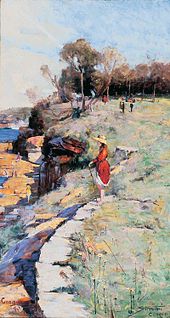
Australian visual arts are thought to have begun with the cave and bark paintings of its Indigenous peoples. The traditions of Indigenous Australians are largely transmitted orally and are closely tied to ceremony and the telling of the stories of the Dreamtime. Australian Aboriginal music, dance, and art have a palpable influence on contemporary Australian visual and performing arts, with Indigenous Australian artists such as Emily Kngwarreye and Gordon Bennett continuing to evolve the traditional Aboriginal art forms. From the time of European settlement, a common theme in Australian art has been the Australian landscape, seen for example in the works of the Indigenous artist Albert Namatjira, Arthur Streeton and others associated with the Heidelberg School, and Arthur Boyd. The advent of post–World War II modern art in Australia drew controversy; the Heide Circle and the Antipodeans Group were formed in opposition to abstract art and its growing influence on Australian culture, predating other pro-figurative art movements such as Stuckism, which also has a strong Australian presence led by Godfrey Blow and Regan Tamanui. Australian artists who were influenced by the modern American and European art at the time include cubist Grace Crowley, surrealist James Gleeson, abstract expressionist Brett Whiteley, and pop artist Martin Sharp. Australians are keen visitors to art galleries, and the National Gallery of Australia and the various state galleries have strong Australian and overseas collections. From early in the 20th century until the present, the country's unique landscape remains among the greatest sources of inspiration for Australian modernist artists; it has been depicted in highly acclaimed and innovative works by Sidney Nolan, Grace Cossington Smith, Fred Williams, Sydney Long, Clifton Pugh, and many others.

Australia has an active tradition of music, ballet, and theatre; many of its performing arts companies receive public funding through the federal government's Australia Council. There is a symphony orchestra in each state's capital city, and a national opera company, Opera Australia, first made prominent by the renowned diva Joan Sutherland. Nellie Melba was her great predecessor. Australian music covers vast ground in classical, jazz, the avant-garde, and many popular genres. Australian musicians of international repute include rock bands AC/DC, INXS, and Silverchair, and singer songwriters Nick Cave and Lisa Gerrard. Australian pop stars such as Olivia Newton-John and Kylie Minogue have become global celebrities. Ballet and dance are also represented across the nation by The Australian Ballet and various state dance companies. Robert Helpmann is considered one of Australia's greatest dancers and has been followed by numerous others including the current artistic director of the Australian Ballet, David McAllister, and the choreograper Graeme Murphy. Each state has a publicly funded theatre company.

Australia has had a prosperous cinema industry since the 1960s and the ensuing New Wave of Australian cinema. Its history, however, extends back to the early 20th century with the release of the 1906 The Story of the Kelly Gang, a 70-minute account of the Australian folk hero Ned Kelly, which is generally regarded as the world's first feature-length film. Other famous films include Mad Max, Gallipoli, Shine, Rabbit-Proof Fence, and Happy Feet. Australia's diverse landscapes and cities have served as primary locations for many other films, such as The Matrix, Peter Pan, Superman Returns, and Finding Nemo. Well-known Australian actors include Judith Anderson, Errol Flynn, Nicole Kidman, Hugh Jackman, Heath Ledger, Geoffrey Rush, Russell Crowe, Toni Collette, Naomi Watts, and current joint director of the Sydney Theatre Company, Cate Blanchett. Comedy is one of the most popular forms of entertainment in Australia; Barry Humphries, Norman Gunston, Roy & HG, John Safran, Tim Minchin, The Chaser, Rove McManus, Chris Lilley, and Hamish & Andy are among Australia's most famous comedians.
Australian literature has also been influenced by the landscape; the works of writers such as Banjo Paterson, Henry Lawson, and Dorothea Mackellar captured the experience of the Australian bush. The character of colonial Australia, as embodied in early literature, resonates with modern Australia and its perceived emphasis on egalitarianism, mateship, and a perceived anti-authoritarianism. In 1973, Patrick White was awarded the Nobel Prize in Literature, the only Australian to have achieved this; he is recognised as one of the great English-language writers of the 20th century. Colleen McCullough, David Williamson, and David Malouf are also writers of great renown.
Australia has two public broadcasters (the Australian Broadcasting Corporation and the multicultural Special Broadcasting Service), three commercial television networks, several pay-TV services, and numerous public, non-profit television and radio stations. Each major city has daily newspapers, and there are two national daily newspapers, The Australian and The Australian Financial Review. According to Reporters Without Borders in 2008, Australia was in 25th position on a list of 173 countries ranked by press freedom, behind New Zealand (7th) and the United Kingdom (23rd) but ahead of the United States (48th). This low ranking is primarily because of the limited diversity of commercial media ownership in Australia; in particular, most Australian print media are under the control of News Corporation and John Fairfax Holdings.
Sports
Main article: Sport in Australia
Sport plays an important part in Australian culture, assisted by a climate that favours outdoor activities; 23.5% Australians over the age of 15 regularly participate in organised sporting activities. At an international level, Australia has strong teams in cricket, field hockey, netball, rugby league, rugby union, and international rules football, and it performs well in cycling, rowing, and swimming. Nationally, other popular sports include Australian rules football, horse racing, soccer, and motor racing. Australia has participated in every summer Olympic Games of the modern era, and every Commonwealth Games. Australia hosted the 1956 Summer Olympics in Melbourne and the 2000 Summer Olympics in Sydney, and has ranked among the top six medal-takers since 2000. Australia has also hosted the 1938, 1962, 1982, and 2006 Commonwealth Games. Other major international events held in Australia include the Grand Slam Australian Open tennis tournament, international cricket matches, and the Formula One Australian Grand Prix. Viewing televised sport is popular: the highest-rating television programs include the summer Olympic Games, State of Origin, and the grand finals of the National Rugby League and Australian Football League.
International rankings
Template:International rankings of Australia
See also
- Australian citizenship
- Commonwealth Heritage—places and things on government heritage list
- List of basic Australia topics
Notes
- Australia also has a royal anthem, "God Save the Queen (or King)", which is played in the presence of a member of the Royal Family when they are in Australia. In all other appropriate contexts, the national anthem of Australia, "Advance Australia Fair", is played.
- English does not have de jure status.
- There are minor variations from these three time zones, see Time in Australia.
- Australia describes the body of water south of its mainland as the Southern Ocean, rather than the Indian Ocean as defined by the International Hydrographic Organization (IHO). In 2000, a vote of IHO member nations defined the term "Southern Ocean" as applying only to the waters between Antarctica and 60 degrees south latitude.
- The Oxford English Dictionary records a first occurrence in 1908, in the form Oss.
- Oz is often taken as an oblique reference to the fictional Land of Oz in the film The Wizard of Oz (1939), based on Frank Baum's novel The Wonderful Wizard of Oz (1900). Australians' "image of Australia as a 'Land of Oz' is not new, and dedication to it runs deep". The spelling Oz is likely to have been influenced by the 1939 film, though the pronunciation was probably always with a /z/, as it is also for Aussie, sometimes spelt Ozzie. The Baz Luhrmann film Australia (2008) makes repeated reference to The Wizard of Oz, which appeared just before the wartime action of Australia. One reviewer writes: "You even nod with approval at Luhrmann's audacity for cribbing from 'The Wizard of Oz' in his depiction of his Land of Oz, Australia, as a magical place over the rainbow." Some critics have even speculated that Baum was inspired by Australia, in naming the Land of Oz: "In Ozma of Oz (1907) Dorothy gets back to Oz as the result of a storm at sea while she and Uncle Henry are traveling by ship to Australia. So, like Australia, Oz is somewhere to the west of California. Like Australia, Oz is an island continent. Like Australia, Oz has inhabited regions bordering on a great desert. One might almost imagine that Baum intended Oz to be Australia, or perhaps a magical land in the center of the great Australian desert."
References
- "20680-Ancestry by Country of Birth of Parents - Time Series Statistics (2001, 2006 Census Years) - Australia". Australian Bureau of Statistics. 27 June 2007. Retrieved 2008-12-30.
- "Demonyms - Names of Nationalities". about.com. Retrieved 2008-07-23.
- "Demonyms, or what do you call a person from ..." The Geography Site. Retrieved 2008-07-25.
- "Population clock". Australian Bureau of Statistics. Retrieved 2008-10-26.
- Australian Bureau of Statistics (25 October 2007). "Australia". 2006 Census QuickStats. Retrieved 2008-10-14.
- ^ "Australia". International Monetary Fund. Retrieved 2008-10-09.
- First Australians Documentary (Episode 1), Special Broadcasting Service, Australia, 2008.
- Both Australian Aborigines and Europeans Rooted in Africa - 50,000 years ago
- MacKnight, CC (1976). The Voyage to Marege: Macassan Trepangers in Northern Australia. Melbourne University Press
- "Australia: World Audit Democracy Profile". WorldAudit.org. Retrieved 2008-01-05.
- Purchas, vol. iv, p. 1422–32, 1625. This appears to be variation of the original Spanish "Austrialia" . A copy at the Library of Congress can be read online
- Sidney J. Baker, The Australian Language, second edition, 1966.
- Weekend Australian, 30–31 December 2000, p. 16
- Australian pronunciations: Macquarie Dictionary, Fourth Edition (2005). Melbourne, The Macquarie Library Pty Ltd. ISBN 1-876429-14-3
- Gillespie, R. (2002). Dating the first Australians. Radiocarbon 44:455–72; "Dating the First Australians". Ingenta. Retrieved 2008-03-18.
- Convict Records Public Record office of Victoria; State Records Office of Western Australia
- Australian Bureau of Statistics 1998 Special Article—The State of New South Wales
- Smith, L. (1980), The Aboriginal Population of Australia, Australian National University Press, Canberra
- Smallpox Through History
- Tatz, Colin (1999). "Genocide in Australia". AIATSIS Research Discussion Papers No 8. Australian Institute of Aboriginal and Torres Strait Islander Studies. Archived from the original on 2005-08-08. Retrieved 2007-09-13.
- Windschuttle, K. (2001). The Fabrication of Aboriginal History, The New Criterion Vol. 20, No. 1, 20 September.
- Bean, C. Ed. (1941). Volume I - The Story of Anzac: the first phase, First World War Official Histories, Eleventh Edition.
- "Rudd angered by Gallipoli remarks". BBC News. 1 November 2008. Retrieved 2 November 2008.
- Australia Act text
- Parliamentary Library (1997). The Reserve Powers of the Governor-General
- "What happens if I do not vote?". Voting Australia - Frequently Asked Questions. Australian Electoral Commission. Retrieved 2008-01-08.
- Australian Government. (2005). Budget 2005–2006
- Center for Global Development. Commitment to Development Index: Australia, www.cgdev.org. Retrieved on 5 January 2008.
- Nation Master
- Australian Department of Defence (2006).Portfolio Budget Statements 2006–07.Page 19.
- Khosa, Raspal (2004). Australian Defence Almanac 2004–05. Canberra: Australian Strategic Policy Institute. p. 4.
- "Australia's Size Compared". Geoscience Australia. Retrieved 2007-05-19.
- "State of the Environment 2006". Department of the Environment and Water Resources. Retrieved 2007-05-19.
- UNEP World Conservation Monitoring Centre (1980). "Protected Areas and World Heritage - Great Barrier Reef World Heritage Area". Department of the Environment and Heritage. Retrieved 2007-05-19.
- "Mount Augustus". The Sydney Morning Herald. Retrieved 2007-05-19.
- No more drought: it's a "permanent dry"; Australia's epic drought: The situation is grim.
- Atmosphere: Major issue: climate change, Australian State of the Environment Committee, 2006
- ANU poll finds ‘it’s the environment, stupid’, www.anu.edu.au. Retrieved on 8 January 2008.
- Australia Sets Target of 15% Carbon Reduction by 2020, Announces 2010 Carbon Market, www.greencarcongress.com. Retrieved on 8 January 2008.
- http://www.bom.gov.au/climate/change/rerain.shtml
- Saving Australia's water, BBC News, 23 April 2008
- "About Biodiversity". Department of the Environment and Heritage. Archived from the original on 2007-02-05. Retrieved 2007-09-18.
- Lambertini, A Naturalist's Guide to the Tropics, excerpt at www.press.uchicago.edu
- "2005 Environmental Sustainability Index (pg.112)" (PDF). Yale University. Retrieved 2007-05-20.
- "Snake Bite", The Australian Venom Compendium.
- Savolainen, P. et al. 2004. A detailed picture of the origin of the Australian dingo, obtained from the study of mitochondrial DNA. Proceedings of the National Academy of Sciences of the United States of America. 101:12387–12390 PMID
- "Additional Thylacine Topics: Persecution". The Thylacine Museum. 2006.
{{cite web}}: Unknown parameter|accessdaymonth=ignored (help); Unknown parameter|accessyear=ignored (|access-date=suggested) (help); "National Threatened Species Day". Department of the Environment and Heritage, Australian Government. 2006.{{cite web}}: Unknown parameter|accessdaymonth=ignored (help); Unknown parameter|accessyear=ignored (|access-date=suggested) (help) - "Liveability ranking: Urban idylls
- ^ Downwonder The Economist, 29 March 2007
- Macfarlane, I. J. (1998). Australian Monetary Policy in the Last Quarter of the Twentieth Century. Reserve Bank of Australia Bulletin, October
- Parham, D. (2002). Microeconomic reforms and the revival in Australia’s growth in productivity and living standards. Conference of Economists, Adelaide, 1 October
- Australian Bureau of Statistics. Labour Force Australia. Cat#6202.0
- Department of Foreign Affairs and Trade (2003). Advancing the National Interest, Appendix 1
- ^ Australian Bureau of Statistics. Year Book Australia 2005
- "AUSTRALIA: population growth of the whole country". populstat.info. Retrieved 2008-07-22. 19th century figures do not include the indigenous population
- "3105.0.65.001—Australian Historical Population Statistics, 2006" (XLS). Australian Bureau of Statistics. 23 May 2006. Retrieved 2007-09-18.
Australian population: (1919) 5,080,912; (2006) 20,209,993
- "Background note: Australia". US Department of State. Retrieved 2007-05-19.
- ^ Australian Immigration Fact Sheet
- Australian Population: Ethnic Origins
- "The Evolution of Australia's Multicultural Policy". Department of Immigration and Multicultural and Indigenous Affairs. 2005. Archived from the original on 2006-02-19. Retrieved 2007-09-18.
- Settler numbers on the rise
- Inflow of foreign-born population by country of birth, by year; Australian Immigration Fact Sheet 20. Migration Programme Planning Levels
- Immigration intake to rise to 300,000, 11/06/2008
- 300,000 skilled workers needed - Evans
- Michelle Grattan (8 December 2006). "Australia hides a 'failed state'". The Age. Retrieved 17 October 2008.
"Extract: Dear Mr Rudd". Safecom. Retrieved 2008-10-17. (3rd last paragraph) - Parliament of Australia, Parliamentary Library (2005). Australia’s ageing workforce
- Parliament of Australia, Senate (2005). Inquiry into Australian Expatriates
- ^ "Pluralist Nations: Pluralist Language Policies?". 1995 Global Cultural Diversity Conference Proceedings, Sydney. Department of Immigration and Citizenship. Retrieved 2009-01-11. "English has no de jure status but it is so entrenched as the common language that it is de facto the official language as well as the national language."
- Religious Affiliation in Australia, www.abs.gov.au. Retrieved on 7 January 2009.
- Morris, Lindy. God's OK, it's just the religion bit we don't like (2008), Sydney Morning Herald. Retrieved on 5 January 2008.
- National Church Life Survey: church-going declines further, www.ad2000.com.au. Retrieved on 5 January 2008.
- NCLS releases latest estimates of church attendance, National Church Life Survey, Media release, 28 February 2004
- OECD 42/8/39700724
- Education at Glance 2005 by OECD: Percentage of foreign students in tertiary education.
- "Regional Population, 2021". Australian Bureau of Statistics. 11 February 2022.
- Welch, David. "Aboriginal Fine Arts Gallery", aaia.com.au. Retrieved on 2 November 2008.
- Barr, Trevor. "Media Ownership in Australia", australianpolitics.com. Retrieved on 2 January 2008.
- "Australian Film Commission. What are Australians Watching?" Free-to-Air, 1999–2004 TV
- It's an Honour - Symbols - Australian National Anthem and DFAT - "The Australian National Anthem"; "National Symbols". Parliamentary Handbook of the Commonwealth of Australia (29th Edition ed.). 2002 (updated 2005).
{{cite book}}:|access-date=requires|url=(help);|edition=has extra text (help); Check date values in:|year=(help); External link in|chapterurl=|chapterurl=ignored (|chapter-url=suggested) (help)CS1 maint: year (link) - Jacobson, H., In the Land of Oz, Penguin, 1988, ISBN 0140109668.
- The Americana Annual: 1988, Americana Corporation, vol. 13, 1989, p. 66, ISBN 0717202208.
- Partridge, E., et al., The New Partridge Dictionary of Slang and Unconventional English, Taylor & Francis, 2006, ISBN 041525938X, entries "Oz" and "Ozzie", p. 1431.
- " 'Australia' too big to be controlled", The Salt Lake Tribune.
- Algeo, J., "Australia as the Land of Oz", American Speech, Vol. 65, No. 1, 1990, pp. 86–89.
Bibliography
- Denoon, Donald, et al. (2000). A History of Australia, New Zealand, and the Pacific. Oxford: Blackwell. ISBN 0631179623.
- Hughes, Robert (1986). The Fatal Shore: The Epic of Australia's Founding. Knopf. ISBN 0394506685.
- Macintyre, Stuart (2000). A Concise History of Australia. Cambridge, U.K.: Cambridge University Press. ISBN 0521623596.
- Powell, J. M. (1988). An Historical Geography of Modern Australia: The Restive Fringe. Cambridge, U.K.: Cambridge University Press. ISBN 0521256194.
External links
Listen to this article(3 parts, 36 minutes)
- Template:Wikimapia
- About Australia from the Department of Foreign Affairs and Trade
- Governments of Australia Entry Point (Federal, State & Territory)
- Australian Government Entry Portal
- Parliament of Australia: Who's Who (includes head of state)
- Parliament of Australia: Ministry List
- Australian Bureau of Statistics
- Community organisations portal
- Cultural Institutions
- Tourism Australia
- Template:Wikitravel
- "Australia". The World Factbook (2025 ed.). Central Intelligence Agency.
- Australia at UCB Libraries GovPubs
- Template:Dmoz
Template:Link FA Template:Link FA Template:Link FA Template:Link FA
Categories: